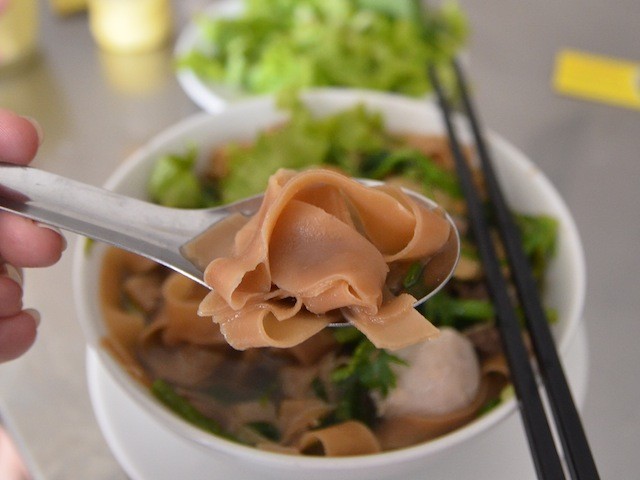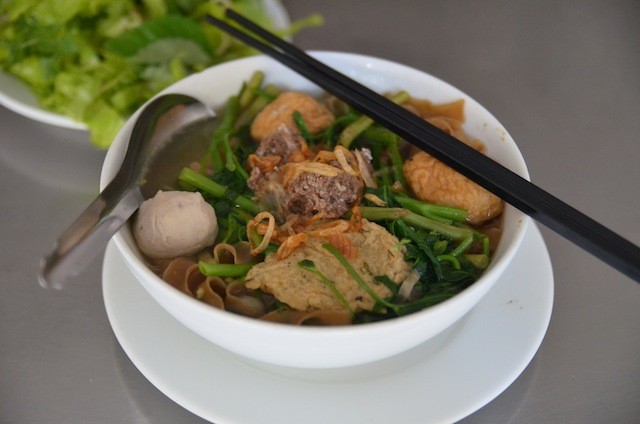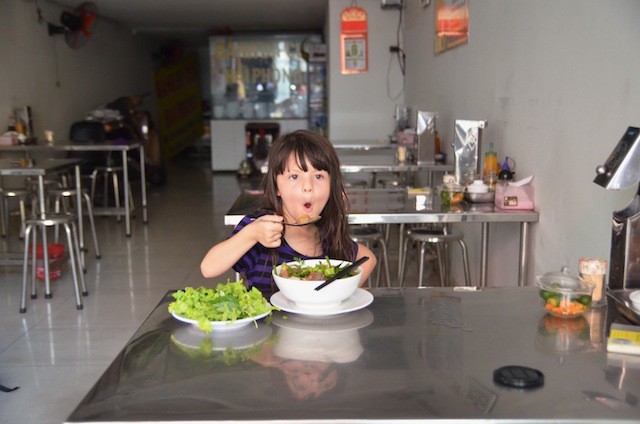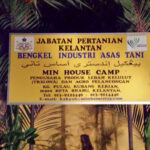Hai Phong Banh Da Cua is a culinary gem, a must-try for any food enthusiast exploring Vietnam, and SIXT.VN is here to guide you through every step of your delicious adventure. Its unique noodles and flavorful broth offer an unforgettable taste of authentic Vietnamese cuisine. Let SIXT.VN help you plan your food tour, find the best hotels, and even arrange airport transfers for a hassle-free trip.
1. What is Banh Da Cua and Where Does It Come From?
Banh Da Cua is a popular Vietnamese crab noodle soup dish originating from Hai Phong, a vibrant port city in northern Vietnam known for its industrial activities and seafood. The dish stands out due to its unique ingredients and preparation methods, offering a distinctive culinary experience.
- Origin and History: Banh Da Cua is deeply rooted in Hai Phong’s culinary culture. The dish reflects the region’s abundance of fresh seafood and agricultural products.
- Culinary Significance: It showcases a blend of flavors and textures. It distinguishes itself from other noodle soups in Vietnam. The dish is a testament to Hai Phong’s unique culinary identity.
- Popularity: Banh Da Cua is not only a local favorite. It has gained recognition throughout Vietnam and internationally. Many tourists and food enthusiasts actively seek it out.
2. What Kind of Noodles are Used in Banh Da Cua?
The noodles, known as “banh da,” are a key element of this dish. Unlike other Vietnamese noodle soups that use rice vermicelli or pho noodles, Banh Da Cua features flat, brown-reddish noodles made from rice flour. These noodles offer a chewier texture and a subtly roasted flavor, enhancing the overall sensory experience.
- Distinctive Characteristics: Banh da noodles are wider and flatter than pho noodles. Their color comes from the roasting process.
- Production Process: The noodles are made by grinding rice into a fine flour, mixing it with water, and then steaming the mixture into thin sheets. These sheets are then cut into wide noodles.
- Texture and Taste: The roasting process gives banh da noodles a unique, slightly smoky flavor and a firm, chewy texture that perfectly complements the rich broth and other ingredients in the soup.
3. What Ingredients are in the Banh Da Cua Broth?
The broth is the heart of Banh Da Cua. It’s crafted from a combination of crab (cua), pork bones, and various seasonings. The broth-making process is intricate, requiring hours of simmering to extract the full flavors from the crab and bones. The result is a rich, savory, and slightly sweet broth that provides the perfect foundation for the dish.
- Crab (Cua): Freshwater crabs are the star ingredient, lending their sweet and briny essence to the broth. The crabs are typically pounded or ground to release their flavors before being simmered.
- Pork Bones: These add depth and richness to the broth. They complement the crab flavor. The bones are simmered for an extended period. This makes the broth hearty and satisfying.
- Seasonings: Essential seasonings include fish sauce (nuoc mam), salt, sugar, and sometimes a touch of shrimp paste (mam tom) to enhance the umami flavor.
4. How is Banh Da Cua Traditionally Prepared?
Preparing Banh Da Cua involves several key steps, each contributing to the dish’s distinctive character. Here’s a breakdown:
- Preparing the Crab: The freshwater crabs are cleaned thoroughly and then either pounded or ground into a paste. This paste is then strained to extract the crab essence, which is used to create the broth.
- Simmering the Broth: The crab essence and pork bones are combined in a large pot with water and simmered for several hours. The cook skims off any impurities that rise to the surface, ensuring a clear and flavorful broth.
- Cooking the Noodles: The banh da noodles are cooked separately. They are added to the bowl just before serving to prevent them from becoming too soft.
- Assembling the Dish: The noodles are placed in a bowl, and then the hot broth is poured over them. Toppings such as crab meat, pork balls, betel leaf-wrapped beef (bo la lot), and various greens are added to complete the dish.
5. What Toppings and Garnishes are Commonly Used in Banh Da Cua?
The toppings and garnishes play a crucial role in enhancing the flavor and texture of Banh Da Cua. Common additions include:
- Crab Meat (Gach Cua): Adds a burst of fresh, sweet flavor.
- Pork Balls (Cha Sua): Made from seasoned ground pork. They offer a savory contrast to the crab.
- Betel Leaf-Wrapped Beef (Bo La Lot): Grilled beef wrapped in betel leaves. They add a smoky, aromatic element.
- Morning Glory (Rau Muong): A popular Vietnamese vegetable. It provides a fresh, crunchy texture.
- Green Onions and Cilantro: These herbs add a fresh, aromatic touch.
- Bean Sprouts: These provide a crisp, refreshing contrast.
- Chili Paste: This is offered on the side. It allows diners to customize the spice level.
 Hai Phong Banh Da Cua features pork balls, crab meat, and aromatic herbs
Hai Phong Banh Da Cua features pork balls, crab meat, and aromatic herbs
6. What Does Banh Da Cua Taste Like?
Banh Da Cua offers a harmonious blend of flavors and textures. The rich, savory broth is perfectly balanced by the chewy noodles and the fresh toppings. The crab meat provides a sweet and briny flavor. The pork balls add a savory depth. The herbs and vegetables contribute a refreshing element. The dish is a symphony of tastes and textures. It leaves a lasting impression.
- Overall Flavor Profile: The dominant flavors are the rich, savory broth. The fresh crab and the aromatic herbs are also important.
- Textural Elements: The chewy noodles, tender crab meat, and crunchy vegetables create a delightful textural contrast.
7. Where Can You Find Authentic Banh Da Cua in Hai Phong?
To experience the most authentic Banh Da Cua, visit Hai Phong. The city has numerous local eateries and street vendors specializing in this dish.
- Recommended Eateries:
- Quan Ba Cu: A well-known spot famous for its traditional Banh Da Cua.
- Banh Da Cua Dinh Dong: Another popular choice among locals and tourists.
- Street Food Stalls: Exploring the street food scene in Hai Phong can lead to the discovery of hidden gems. These offer unique and authentic versions of Banh Da Cua.
- Tips for Finding Quality: Look for places that are popular with locals. Observe the freshness of the ingredients. Don’t hesitate to ask for recommendations.
8. How Does Banh Da Cua Differ From Other Vietnamese Noodle Soups?
Banh Da Cua stands apart from other Vietnamese noodle soups due to its unique noodles, broth, and toppings. While pho and bun bo hue are popular choices, Banh Da Cua offers a distinct culinary experience.
- Noodle Type: Banh Da Cua uses the flat, brown-reddish banh da noodles. Pho uses white rice noodles.
- Broth Base: The broth of Banh Da Cua is primarily crab-based. Pho’s broth is typically beef or chicken-based.
- Toppings: Banh Da Cua includes crab meat, pork balls, and betel leaf-wrapped beef. Pho typically includes sliced beef or chicken.
9. Can You Make Banh Da Cua at Home?
Yes, you can recreate Banh Da Cua at home. However, it requires time and effort to source the ingredients and prepare the broth properly.
- Essential Ingredients:
- Banh da noodles
- Freshwater crabs
- Pork bones
- Fish sauce
- Shrimp paste
- Morning glory
- Green onions
- Cilantro
- Step-by-Step Instructions:
- Prepare the crab by cleaning and grinding it into a paste.
- Simmer the crab paste and pork bones in water for several hours to create the broth.
- Cook the banh da noodles separately.
- Assemble the dish by placing the noodles in a bowl. Then, pour the hot broth over them and add the toppings.
- Tips for Success:
- Use fresh, high-quality ingredients for the best flavor.
- Simmer the broth for an extended period to extract maximum flavor.
- Adjust the seasonings to your taste preferences.
10. What are the Health Benefits of Eating Banh Da Cua?
Banh Da Cua can offer several health benefits, thanks to its nutrient-rich ingredients:
- Protein Source: Crab meat and pork balls provide a good source of protein, essential for muscle building and repair.
- Vitamins and Minerals: The vegetables and herbs in the dish are rich in vitamins and minerals, contributing to overall health and well-being.
- Low in Fat: Compared to other noodle soups, Banh Da Cua can be relatively low in fat, depending on the preparation methods and the amount of pork used.
- Hydration: The broth helps keep you hydrated. This is particularly important in Vietnam’s hot and humid climate.
11. How Does the Season Affect the Taste of Banh Da Cua?
The availability and quality of ingredients can vary depending on the season, which can influence the taste of Banh Da Cua:
- Crab Availability: Freshwater crabs are typically more abundant during certain times of the year, affecting the availability and price of the dish.
- Vegetable Freshness: Seasonal vegetables can impact the freshness and flavor of the toppings.
- Broth Variations: Some cooks may adjust the broth’s seasoning based on the season, using lighter flavors in the summer and richer flavors in the winter.
12. How Can You Customize Your Banh Da Cua Order?
Many eateries allow you to customize your Banh Da Cua order to suit your preferences:
- Spice Level: You can request more or less chili paste to adjust the spiciness.
- Toppings: You can ask for specific toppings to be added or omitted based on your preferences.
- Noodle Quantity: Some places may allow you to adjust the amount of noodles in your bowl.
- Broth Intensity: Request a stronger or milder broth flavor.
13. What Other Dishes Should You Try in Hai Phong?
While in Hai Phong, be sure to explore other local specialties:
- Nem Cua Be: These crispy crab spring rolls are a must-try appetizer.
- Oc (Seafood): Hai Phong is known for its fresh seafood dishes, including snails, clams, and shrimp prepared in various ways.
- Banh Mi Que: These small, crispy baguettes filled with pate and chili sauce are a popular snack.
- Lau Cua Dong: A hot pot featuring freshwater crabs and various vegetables.
 Banh Da Cua offers a symphony of tastes and textures.
Banh Da Cua offers a symphony of tastes and textures.
14. What is the Cultural Significance of Banh Da Cua in Hai Phong?
Banh Da Cua is more than just a dish; it’s a symbol of Hai Phong’s culinary heritage and cultural identity. The dish is often served during family gatherings and special occasions.
- Local Pride: Hai Phong residents take great pride in their Banh Da Cua. They consider it a culinary treasure.
- Community Connection: Banh Da Cua is often enjoyed in communal settings. It fosters a sense of community and togetherness.
- Culinary Tradition: The preparation and enjoyment of Banh Da Cua have been passed down through generations. This preserves the city’s culinary traditions.
15. How Has Banh Da Cua Evolved Over Time?
Like many traditional dishes, Banh Da Cua has evolved over time, with different variations emerging:
- Regional Variations: Different regions of Vietnam may have their own versions of Banh Da Cua. They incorporate local ingredients and flavors.
- Modern Interpretations: Some chefs have introduced modern twists to the dish. They experiment with new ingredients and techniques.
- Preservation of Tradition: Despite these variations, many eateries continue to prepare Banh Da Cua. This is done using traditional methods. The authentic flavor is preserved.
16. What are Some Common Misconceptions About Banh Da Cua?
There are a few misconceptions about Banh Da Cua that are worth clarifying:
- All Crab Noodle Soups are the Same: Banh Da Cua is distinct from other crab noodle soups. It uses unique noodles and preparation methods.
- It’s Always Spicy: While chili paste is often served with the dish, Banh Da Cua itself is not inherently spicy.
- It’s Difficult to Make at Home: While it requires some effort, Banh Da Cua can be made at home with the right ingredients and instructions.
17. How Can SIXT.VN Enhance Your Culinary Experience in Vietnam?
SIXT.VN offers a range of services to enhance your culinary journey in Vietnam, making it more convenient and enjoyable:
- Transportation: SIXT.VN provides reliable airport transfer services. This ensures a smooth and hassle-free arrival and departure.
- Accommodation: SIXT.VN helps you find the perfect hotel in Hanoi or Hai Phong, catering to your budget and preferences.
- Local Insights: SIXT.VN offers valuable local insights and recommendations. This helps you discover the best Banh Da Cua spots and other culinary gems.
18. What Travel Tips Should You Keep in Mind When Visiting Hai Phong?
Visiting Hai Phong can be a rewarding experience. Keep these travel tips in mind:
- Best Time to Visit: The best time to visit Hai Phong is during the dry season (October to April) when the weather is pleasant.
- Transportation Options: Hai Phong has various transportation options, including taxis, buses, and motorbikes.
- Local Customs: Respect local customs and traditions to ensure a smooth and enjoyable trip.
- Language: While English is spoken in tourist areas, learning a few basic Vietnamese phrases can be helpful.
19. How to Order Banh Da Cua Like a Local?
To order Banh Da Cua like a local, use these phrases:
- “Cho toi mot bat banh da cua” (Give me a bowl of banh da cua).
- “Khong cay” (Not spicy).
- “Them rau” (More vegetables).
- “Bao nhieu tien mot bat?” (How much is a bowl?).
20. Why is Banh Da Cua a Must-Try Dish for Food Lovers?
Banh Da Cua is a must-try dish for food lovers. This is because of its unique flavors, textures, and cultural significance. It offers a culinary adventure. It provides a taste of authentic Vietnamese cuisine.
- Unique Flavor Profile: The combination of crab, pork, and aromatic herbs creates a distinctive and unforgettable flavor.
- Cultural Experience: Enjoying Banh Da Cua offers a glimpse into Hai Phong’s culinary heritage and local culture.
- Memorable Meal: Whether you’re a seasoned foodie or a casual traveler, Banh Da Cua is sure to leave a lasting impression.
21. What are the Best Photography Spots in Hai Phong While Enjoying Banh Da Cua?
Combine your culinary adventure with some stunning photography by visiting these spots:
- Local Eateries: Capture the vibrant atmosphere of the local eateries where Banh Da Cua is served.
- Hai Phong’s Waterfront: The waterfront offers scenic backdrops for photos of your meal with the city’s skyline in the background.
- Du Hang Pagoda: This historic pagoda provides a cultural setting for capturing the essence of Hai Phong.
 The soup also contains pork balls, two different type of crab cake, pounded-up rice paddy crab and *bò lá lốt*, beef wrapped in betel leaves
The soup also contains pork balls, two different type of crab cake, pounded-up rice paddy crab and *bò lá lốt*, beef wrapped in betel leaves
22. Where Can You Find Vegetarian or Vegan Adaptations of Banh Da Cua?
Finding vegetarian or vegan versions of Banh Da Cua can be challenging. Traditional recipes rely heavily on crab and pork. However, some vegetarian restaurants in Vietnam may offer plant-based adaptations:
- Vegetarian Eateries: Search for vegetarian restaurants in Hanoi or Hai Phong that may offer a vegan Banh Da Cua.
- Custom Requests: Inquire if restaurants can prepare a vegetarian version using tofu or mushrooms in place of meat.
- Online Recipes: Explore online recipes for vegan Banh Da Cua to prepare at home.
23. How Does Banh Da Cua Reflect Vietnamese Culinary Philosophy?
Banh Da Cua exemplifies several key aspects of Vietnamese culinary philosophy:
- Balance of Flavors: The dish harmoniously combines sweet, savory, and umami flavors.
- Use of Fresh Ingredients: Fresh, locally sourced ingredients are essential to the dish’s flavor and nutritional value.
- Emphasis on Texture: The combination of chewy noodles, tender meat, and crunchy vegetables creates a satisfying textural experience.
- Cultural Significance: Banh Da Cua represents a connection to local traditions and community values.
24. What Kind of Drinks Pair Well with Banh Da Cua?
To complement the flavors of Banh Da Cua, consider these drink pairings:
- Vietnamese Iced Tea (Tra Da): A refreshing and cooling beverage that balances the richness of the broth.
- Fresh Coconut Water (Nuoc Dua): A hydrating and slightly sweet option that complements the savory flavors.
- Local Beer (Bia Hoi): A light and crisp beer that pairs well with the dish’s umami notes.
25. What Souvenirs Related to Banh Da Cua Can You Bring Home?
If you want to bring a piece of your Banh Da Cua experience home, consider these souvenirs:
- Banh Da Noodles: Purchase dried banh da noodles to recreate the dish at home.
- Fish Sauce: High-quality fish sauce is a staple ingredient in Vietnamese cuisine.
- Vietnamese Coffee: A bag of Vietnamese coffee beans and a traditional phin filter.
- Cookbook: A Vietnamese cookbook featuring local recipes.
26. What Events or Festivals in Hai Phong Feature Banh Da Cua?
Keep an eye out for local events and festivals in Hai Phong where Banh Da Cua may be featured:
- Hai Phong Tourism Events: Tourism events often showcase local cuisine, including Banh Da Cua.
- Food Festivals: Food festivals in Vietnam may include Banh Da Cua among the featured dishes.
- Cultural Celebrations: Local celebrations and gatherings may offer opportunities to enjoy authentic Banh Da Cua.
27. How Does Banh Da Cua Contribute to Hai Phong’s Economy?
Banh Da Cua plays a significant role in Hai Phong’s economy:
- Tourism: It attracts tourists. This boosts the local economy.
- Local Businesses: Many local businesses depend on the production and sale of Banh Da Cua.
- Employment: The dish provides employment opportunities for cooks, vendors, and suppliers.
- Agricultural Support: The demand for ingredients like crabs and vegetables supports local farmers and producers.
28. How Can You Learn More About Vietnamese Cuisine and Culture?
Immerse yourself in Vietnamese cuisine and culture through these avenues:
- Cooking Classes: Join a Vietnamese cooking class to learn how to prepare Banh Da Cua.
- Cultural Tours: Participate in cultural tours that highlight local traditions.
- Language Learning: Learn basic Vietnamese phrases to enhance your interactions with locals.
- Cultural Events: Attend cultural events and festivals to experience Vietnamese music, dance, and art.
29. What is the Etiquette for Eating Banh Da Cua in Vietnam?
When enjoying Banh Da Cua in Vietnam, keep these etiquette tips in mind:
- Use Chopsticks: Use chopsticks to eat the noodles and toppings.
- Slurping: Slurping noodles is acceptable. This is often seen as a sign of enjoyment.
- Add Condiments: Feel free to add condiments like chili paste or lime juice. This is done to suit your taste.
- Respect Elders: If dining with elders, offer them the first serving as a sign of respect.
30. Why Choose SIXT.VN for Your Vietnam Travel Needs?
SIXT.VN offers unparalleled convenience, reliability, and local expertise for your Vietnam travel needs:
- Comprehensive Services: SIXT.VN provides airport transfers, hotel bookings, and local insights.
- Reliable Transportation: Enjoy a seamless and stress-free travel experience.
- Local Expertise: Benefit from our deep understanding of Vietnamese culture and cuisine.
- Customer Support: Our dedicated customer support team is available to assist you.
31. How to Ensure the Banh Da Cua is Safe to Consume?
To ensure the Banh Da Cua you eat is safe, consider these tips:
- Choose Reputable Vendors: Opt for well-established and clean eateries or street vendors.
- Check Ingredient Freshness: Ensure that the ingredients, especially seafood, appear fresh and properly stored.
- Observe Hygiene Practices: Look for vendors who follow proper hygiene practices, such as wearing gloves and using clean utensils.
- Read Reviews: Check online reviews and ratings to gauge the quality and safety of the food.
32. What are Some Interesting Facts About Crab in Vietnamese Cuisine?
Crab is a beloved ingredient in Vietnamese cuisine. Here are some interesting facts:
- Variety of Crabs: Vietnam boasts a diverse range of crab species, each with unique flavors and textures.
- Traditional Uses: Crab is used in various dishes, from soups and stews to spring rolls and salads.
- Nutritional Value: Crab is a good source of protein, vitamins, and minerals.
- Cultural Symbolism: In Vietnamese culture, crab is often associated with prosperity and good fortune.
33. How to Store Leftover Banh Da Cua Properly?
If you have leftover Banh Da Cua, follow these steps to store it properly:
- Separate Components: Separate the noodles, broth, and toppings into separate containers.
- Cool Down: Allow the broth and toppings to cool down completely before refrigerating.
- Refrigerate: Store the broth and toppings in airtight containers in the refrigerator for up to 2 days. Store the noodles separately to prevent them from becoming soggy.
- Reheat: When reheating, bring the broth to a simmer and add the noodles and toppings just before serving.
34. What are Some Popular Vietnamese Cooking Blogs or Websites to Learn More About Banh Da Cua?
Explore these Vietnamese cooking blogs and websites for more information on Banh Da Cua:
- Vicky Pham: Offers authentic Vietnamese recipes and cooking tips.
- Run Away Rice: Features a variety of Vietnamese dishes.
- Hungry Huy: Provides a local’s perspective on Vietnamese cuisine.
- Asian Inspirations: Showcases a wide range of Asian recipes.
35. How Does Banh Da Cua Compare to Other Crab Soups Around the World?
While crab soups are enjoyed in many cultures, Banh Da Cua stands out due to its unique flavor profile and ingredients:
- Bouillabaisse (France): A seafood stew featuring various types of fish and shellfish.
- Maryland Crab Soup (USA): A tomato-based soup with crab meat and vegetables.
- Tom Yum (Thailand): A hot and sour soup with shrimp or crab and aromatic herbs.
- Laksa (Malaysia/Singapore): A spicy coconut milk-based soup with noodles and seafood.
Banh Da Cua distinguishes itself through its crab-based broth, banh da noodles, and traditional Vietnamese toppings.
36. What is the Future of Banh Da Cua in the Culinary World?
The future of Banh Da Cua looks promising. The dish is gaining recognition worldwide:
- Global Recognition: More and more people are discovering and appreciating Banh Da Cua.
- Innovation: Chefs are experimenting with new twists and variations. This preserves the dish’s authenticity.
- Cultural Preservation: Efforts are being made to preserve the traditional methods of preparing Banh Da Cua.
- Culinary Tourism: As culinary tourism grows, Banh Da Cua will continue to attract food lovers to Hai Phong.
37. What Role Does Social Media Play in Promoting Banh Da Cua?
Social media platforms play a significant role in promoting Banh Da Cua:
- Visual Appeal: Photos and videos of the dish can attract potential diners.
- Reviews and Recommendations: Online reviews and recommendations influence people.
- Food Blogging: Food bloggers share their experiences with Banh Da Cua.
- Tourism Promotion: Tourism organizations use social media to promote Banh Da Cua.
38. What are Some Common Mistakes to Avoid When Making Banh Da Cua at Home?
Avoid these common mistakes when preparing Banh Da Cua at home:
- Using Low-Quality Ingredients: Always use fresh, high-quality ingredients.
- Rushing the Broth: Simmer the broth for an extended period to extract maximum flavor.
- Overcooking the Noodles: Cook the noodles separately and add them to the bowl.
- Skipping the Toppings: Don’t skimp on the toppings. They add flavor and texture.
- Ignoring Seasoning: Adjust the seasonings to your taste preferences.
39. How Has Banh Da Cua Been Adapted for the International Market?
To cater to international palates, Banh Da Cua has been adapted in several ways:
- Adjusted Spice Levels: Some restaurants offer milder versions of the dish to suit international tastes.
- Vegetarian Options: Vegetarian adaptations are available for non-meat eaters.
- Ingredient Substitutions: Some ingredients may be substituted with more readily available alternatives.
- Presentation: The dish may be presented differently. It can appeal to international diners.
40. How Can I Book A Tour To Hai Phong With SIXT.VN To Try Banh Da Cua?
Booking a tour to Hai Phong with SIXT.VN to try Banh Da Cua is simple:
- Visit SIXT.VN: Navigate to the SIXT.VN website.
- Select Tour Packages: Explore our range of tour packages.
- Choose Hai Phong Tour: Select the Hai Phong tour option.
- Customize Your Tour: Tailor the tour to your preferences.
- Book Your Tour: Confirm and book your tour.
FAQ: Discovering the Delights of Hai Phong Banh Da Cua
1. What exactly is Banh Da Cua?
Banh Da Cua is a traditional Vietnamese crab noodle soup from Hai Phong, featuring unique brown noodles and a rich crab-based broth.
2. What makes the noodles in Banh Da Cua special?
The noodles, called “banh da,” are flat, brown-reddish, and chewier than typical rice noodles. They have a roasted rice flavor.
3. What are the main ingredients in the broth?
The broth is made from freshwater crabs, pork bones, and seasonings like fish sauce and shrimp paste.
4. What kind of toppings are commonly added to Banh Da Cua?
Common toppings include crab meat, pork balls, betel leaf-wrapped beef, morning glory, and fresh herbs.
5. Where can I find the best Banh Da Cua in Hai Phong?
Popular spots include Quan Ba Cu and Banh Da Cua Dinh Dong, as well as numerous street food stalls.
6. How does Banh Da Cua differ from other Vietnamese noodle soups like pho?
Banh Da Cua uses unique noodles and a crab-based broth. Pho uses white rice noodles and beef or chicken broth.
7. Is it possible to make Banh Da Cua at home?
Yes, but it requires time and effort to source the ingredients and prepare the broth properly.
8. What are the health benefits of eating Banh Da Cua?
It’s a good source of protein from crab and pork, and the vegetables provide vitamins and minerals.
9. How can I customize my Banh Da Cua order?
You can customize the spice level, toppings, noodle quantity, and broth intensity to your liking.
10. Can SIXT.VN help me plan a trip to try Banh Da Cua in Hai Phong?
Yes, SIXT.VN offers transportation, accommodation, and local insights. We make your culinary journey seamless.
With SIXT.VN, planning your food adventure in Vietnam is easy and stress-free. From arranging airport transfers to finding the perfect hotel and recommending the best local eateries, SIXT.VN ensures you have an unforgettable culinary experience. Don’t miss the opportunity to savor the authentic flavors of Banh Da Cua and other Vietnamese delicacies. Visit SIXT.VN today to book your tour and embark on a culinary journey of a lifetime. Contact us at Address: 260 Cau Giay, Hanoi, Vietnam. Hotline/Whatsapp: +84 986 244 358.




